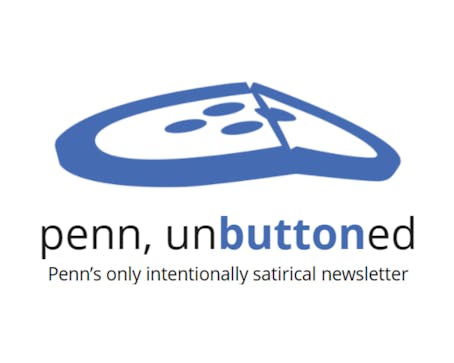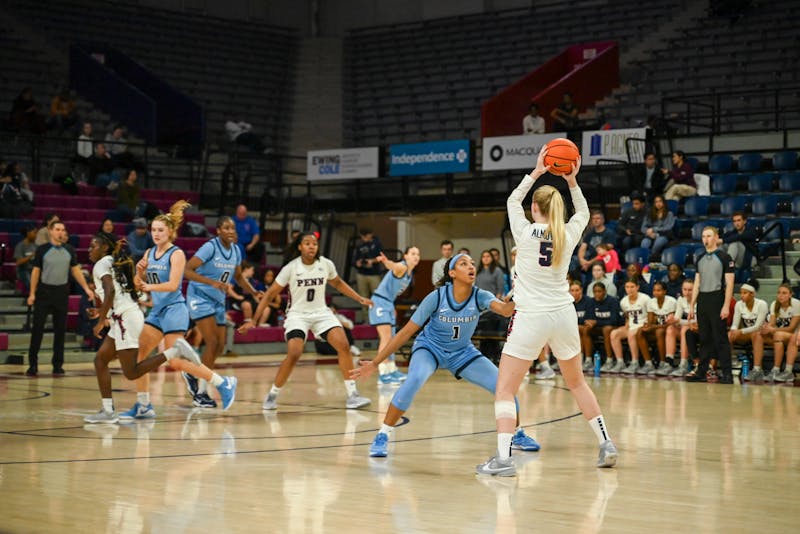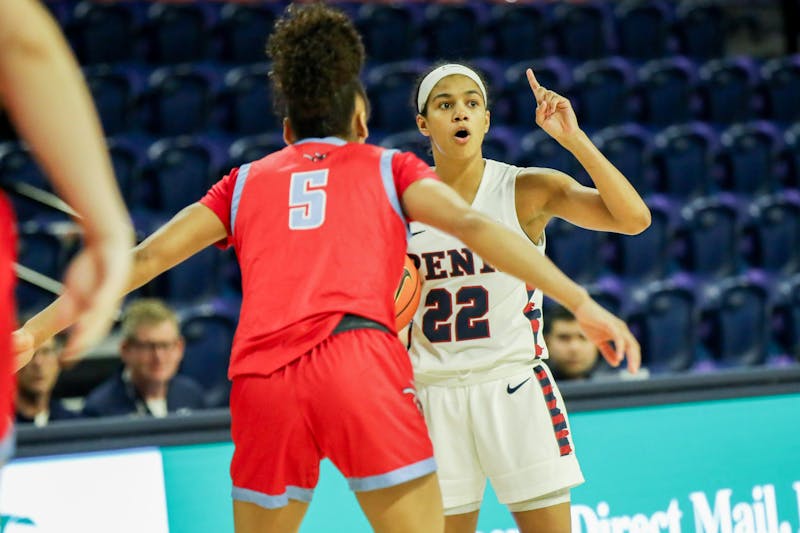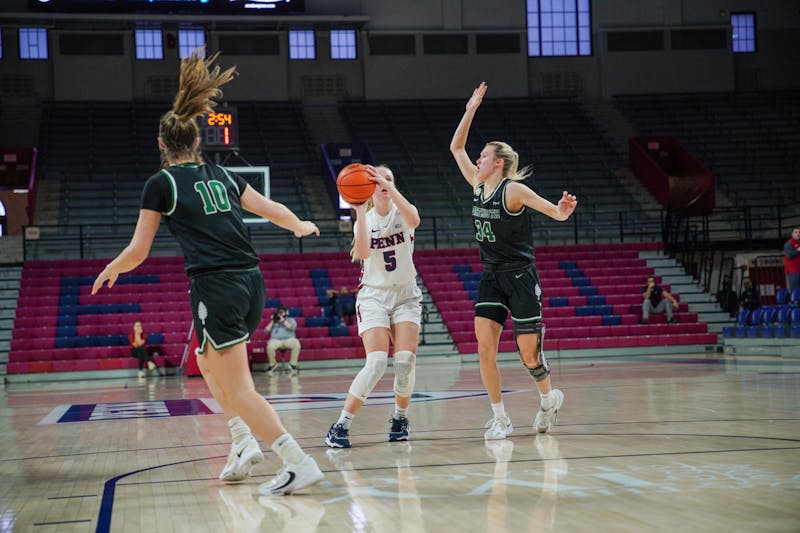
Penn students and faculty members expressed concern about the future of higher education following cuts to graduate admissions rates in exclusive interviews with The Daily Pennsylvanian.
On Feb. 21, Penn informed department chairs that it will cut admissions across School of Arts and Sciences and Perelman School of Medicine graduate programs — a decision faculty members say was made after programs had already accepted students. The decision came after 1968 Wharton graduate and President Donald Trump signed an executive order on Feb. 7 that cut funding from the NIH by imposing a 15% cap on indirect costs, which currently provide funding for overhead research costs such as lab spaces and support staff.
Marco Ruella, an assistant professor at the Medical School who specializes in CAR T-cell immunotherapies, said that most of his research receives funding from the NIH and the National Cancer Institute.
“Some [clinical] trials also are sponsored by the NIH,” Ruella said. “Often, we partner with industry in the later stages to bring it to market or support larger trials. But I would say that the vast majority of the products that make it to a clinical trial or even to approval receive funding from the NIH.”
Ruella described the federal government’s support of scientific research as “something pretty unique” to the United States compared to his home in Europe, “where the government funding for research is very limited.”
Ruella said that he continued to apply for new NIH grants despite the cuts. He explained that, normally, once a grant proposal is written and submitted to the NIH, a study section of about 20-to-40 scientists reviews and ranks the application to determine if it receives federal funding.
Ruella added that a council meeting that occurs after the study section is “really the one” that makes the final decision on which grants receive funding. But after the cap on indirect costs, Ruella’s council meeting — which was scheduled for the beginning of February — “never happened.”
He said that, as someone who also serves as a member of NIH study sections and helps review grants, “there is going to be a backlog of grants that are not being processed,” and these delays have complicated the NIH‘s future goals.
“We want to develop new therapies for patients,” he said. “We want to drive to science. We are sort of … in a standby mode to see what happens.”
Despite calling his research lab “semi-independent within the University,” Ruella emphasized his reliance on the financial support from NIH grants.
“We have the freedom to work, we have the space, we have the resources, but then we need to pay for the people,” Ruella said. “If one of the major funding strategies was the NIH … we might have to revisit the way we manage our labs.”
Ruella said that following the funding cut, he had to tell a postdoctoral student that “we didn’t get the grant,” creating a wave of uncertainty and “instability for the future” from graduate students.
“Postdocs and Ph.D. students are concerned, because they know that their research and their salaries are supported by the NIH,” Ruella said. “One of my Ph.D. students — she’s a National Science Foundation grant — [is] a little bit worried.”
First year mathematics Ph.D. candidate Riley Shahar described the cuts to funding from the National Science Foundation, which currently supports several technological initiatives at Penn, as a primary source of “fear” among graduate students.
Shahar said that the cuts will damage the “intellectual culture” of Penn’s Department of Mathematics.
“We’re a really collaborative department right now,” she said. “That will be harder, and there will be fewer students. It seems likely to me that [the cuts] will make the culture less intellectually vibrant than it is now.”
Shahar said the cuts felt more “worrying … on a national scale than a University scale,” noting the current “moment of national and international skepticism of universities and research.”
“[I] would like to see Penn strengthen their efforts to advocate for the importance of research on a national and an international level, the importance of a functioning democracy,” she added. “I would love to see Penn do more work … to communicate what it is that we do and how … it strengthens the world or the city.”
College senior Sarah O’Konski told the DP that as “someone who‘s trying to get a job,” she has concerns about “seeing in real time people realizing, ‘Oh no, how am I going to fund my next research project? How am I going to take on new graduate students?’”
O’Konski described the shift in institutional “support” of scientific research following the departure of the Biden administration, saying that “we have a very anti-science, anti-intellectual administration coming in,” she added.
O’Konski said that she has begun looking into “pharmaceutical jobs overseas, looking for companies that will sponsor short-term work visas” because of funding uncertainty, even after she had her mind set on going to graduate school.
“During the fall semester, I was starting to get a little bit on the fence,” she said, noting the unfortunate timing of Penn’s announcement of admission changes and that the Chemistry department had hosted its prospective students day for admitted applicants the same day as the announcement.
Although she has not begun the graduate school admissions process, O’Konski described feeling “helpless” during her undergraduate classes.
A SAS professor, who requested anonymity due to fear of retribution, told the DP that their department “had a recruitment day for prospective graduate students and … also those whom we accepted via an informal offer but were asked now not to confirm officially.”
“It was heartbreaking to notice that, on the one hand, we had to woo those students whom we can get to come to Penn, but also had these other students on campus whom we would have wanted to accept, but can’t,” the professor said. “They’re here because they have bought the flight tickets already in advance from Europe and elsewhere to come and look at us.”
“Cutting graduate student stipends this way is more of a symbolic gesture than one that would actually help the University gain financial footing in some major way, if at all,” the professor added.
The professor also drew attention to “the fundamental unfairness to endanger small departments.”
“It’s slowly getting to be existential, and a University with a big name like Penn should not be able to afford this,” they said.
According to a written statement from Penn’s Graduate and Professional Student Assembly, “Penn is a decentralized university, decisions and communications regarding admissions reductions have varied across schools and programs.”
“Some schools have held town halls to provide full transparency, others have disseminated information via email, and some have remained relatively silent,” the statement continued. “GAPSA has heard significant distress, worry, and anxiety from graduate and professional students.”
While GAPSA noted that it was “not aware of any official offers being rescinded,” the statement raised a concern that rescinding offers might damage the reputations of graduate programs and the quality of graduate student labor, as “some programs rely heavily on the Ph.D. cohort as teaching assistants.”
History and Sociology of Science Ph.D. candidate Sam Schirvar — who also serves as an organizer for Graduate Employees Together — University of Pennsylvania, Penn’s largest union — also described how the admissions cuts will impact Penn’s educational abilities.
“Graduate workers are responsible for a very large portion of the teaching work that happens here at Penn, so we’re definitely worried that lower graduate admissions could result in larger class sizes, which would certainly damage the undergraduate experience,” he said, calling the cut to admissions a “misguided decision that will certainly harm Penn’s research and teaching mission.”
He also responded to speculation that Penn changed its graduate admissions process as a reaction to recent efforts among graduate students to unionize, saying that there is “no evidence” of a connection between the two, citing the current financial relationship between GET-UP and the University.
“The financial articles of our collective bargaining agreement — so things like stipend and benefits — haven’t even been proposed by our bargaining committee yet,” Schirvar said. “They’re not even on the table, let alone having reached the final state of negotiation issues. There’s no known financial outcome of the collective bargaining process yet that the University would be able to make financial decisions in response to.”
Ruella, who also serves on the admissions committee for the Gene Therapy and Vaccine program of Penn’s cell and molecular biology graduate group, also noted how the “last-minute” changes to the admissions process have affected students. This year, the selection committee decided to interview 17 candidates and offer admission to 15. In response to Trump’s executive order to cut federal funding, Ruella said that the graduate group decided to reduce the number of accepted applicants from 15 to 10.
“We found ourselves with 17 people interviewed and only 10 slots, which is usually not what we want to have,” Ruella said. “Typically when you offer a Ph.D. position at Penn, people say yes. We don’t want to be in a situation where we need to exclude people that we would love to have.”
He added that it was “heartbreaking not to give the opportunity to” qualified candidates.
Thomas A. Scott Professor of Mathematics Ron Donagi similarly described “difficult circumstances” in a written statement to the DP.
“This year we are allowed to offer admission to only six students (in past years that number was closer to 30),” Donagi wrote. “That’s six out of over 600 applicants. We believe the ones we have selected are the best of the best, and we try to treat them accordingly and to let them know how valued they are.”
“Students who receive our offer have until April 15 to decide,” Donagi wrote. “We do ask them to let us know as soon as they make up their mind — this gives students on the waiting list a chance at a second-round offer.”
Rupa Khanal, who is in the final year of her biology Ph.D. program in SAS, told the DP that students are not the only ones who feel “uncertain” about the future of academia.
“Nobody’s certain about anything anymore. So we are very lost,” she said.
She added that “even professors and individual labs are not super aware of the details of, where does this money go to.”
English professor David Kazanjian, who signed an open letter requesting that graduate admissions be restored to prior levels, said in an interview with the DP that he wished that SAS administration would be more open about its financial circumstances.
“Executive orders are not laws, and many of them have been challenged in court, so it’s unclear to us why they are taking such last-minute, drastic measures in response to potential or perceived financial threats,” he said. “On what basis are they making those calculations? They won’t explain it to us.”
The DP could not confirm how all schools and departments across Penn will be affected by the admission cuts at the time of publication.
However, Margaret Bond Simon Dean of Nursing Antonia Villarruel wrote in a statement to the DP that the School of Nursing has “not been asked by anyone to reduce graduate admissions — at the master’s or doctoral level.”
“I think that this situation certainly could be used as an opportunity to revise the way we support our research,” Ruella said. “I think Penn at all levels should strive to stay united and to come up with a solution where we can continue to achieve our goals.”
The Daily Pennsylvanian is an independent, student-run newspaper. Please consider making a donation to support the coverage that shapes the University. Your generosity ensures a future of strong journalism at Penn.
Donate












